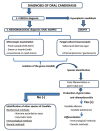Clinical and microbiological diagnosis of oral candidiasis
- PMID: 24455095
- PMCID: PMC3892259
- DOI: 10.4317/jced.51242
Clinical and microbiological diagnosis of oral candidiasis
Abstract
Introduction: Candidiasis or oral candidiasis is the most frequent mucocutaneous mycosis of the oral cavity. It is produced by the genus Candida, which is found in the oral cavity of 53% of the general population as a common commensal organism. One hundred and fifty species have been isolated in the oral cavity, and 80% of the isolates correspond to Candida albicans, which can colonize the oral cavity alone or in combination with other species. Transformation from commensal organism to pathogen depends on the intervention of different predisposing factors that modify the microenvironment of the oral cavity and favor the appearance of opportunistic infection. The present study offers a literature review on the diagnosis of oral candidiasis, with the purpose of establishing when complementary microbiological techniques for the diagnosis of oral candidiasis should be used, and which techniques are most commonly employed in routine clinical practice in order to establish a definitive diagnosis.
Materials and methods: A Medline-PubMed, Scopus and Cochrane search was made covering the last 10 years.
Results: The diagnosis of oral candidiasis is fundamentally clinical. Microbiological techniques are used when the clinical diagnosis needs to be confirmed, for establishing a differential diagnosis with other diseases, and in cases characterized by resistance to antifungal drugs. Biopsies in turn are indicated in patients with hyperplastic candidiasis. Staining (10% KOH) and culture (Sabouraud dextrose agar) are the methods most commonly used for diagnosing primary candidiasis. Identification of the individual species of Candida is usually carried out with CHROMagar Candida®. For the diagnosis of invasive candidiasis, and in cases requiring differentiation between C. albicans and C. dubliniensis, use is made of immunological and genetic techniques such as ELISA and PCR. Key words:Clinical, oral candidiasis, microbiology.
Conflict of interest statement
References
-
- Bensadoun RJ, Patton LL, Lalla RV, Epstein JB. Oropharyngeal candidiasis in head and neck cancer patients treated with radiation: update 2011. Support Care Cancer. 2011;19:737–44. - PubMed
-
- Aguirre-Urízar JM. Oral Candidiasis. Rev Iberoam Micol. 2002;19:17–21. - PubMed
-
- Dorko E, Baranová Z, Jenca A, Kizek P, Pilipcinec E, Tkáciková L. Diabetes mellitus and candidiases. Folia Microbiol (Praha) 2002;50:255–61. - PubMed
-
- Davies AN, Brailsford SR, Beighton D, Shorthose K, Stevens VC. Oral candidosis in community-based patients with advanced cancer. J Pain Symptom Manage. 2008;35:508–14. - PubMed
-
- Delgado AC, de Jesus Pedro R, Aoki FH, Resende MR, Trabasso P, Colombo AL. Clinical and microbiological assessment of patients with a long-term diagnosis of human immunodeficiency virus infection and Candida oral colonization. Clin Microbiol Infect. 2009;15:364–71. - PubMed
Publication types
LinkOut - more resources
Full Text Sources
Other Literature Sources

